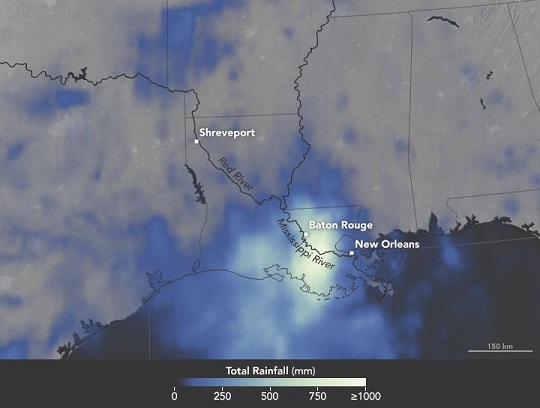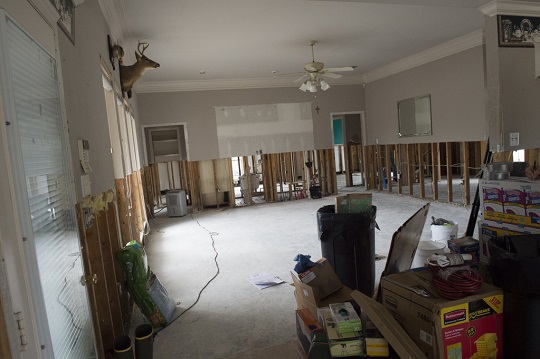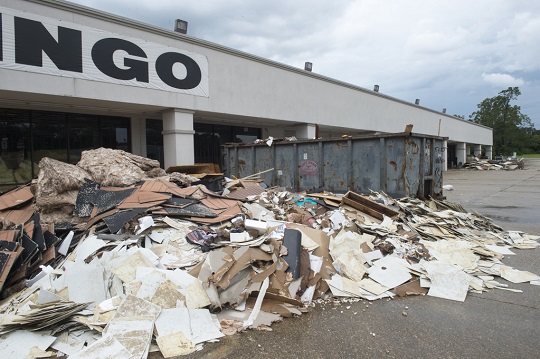Louisiana Flood 2016
Status: Closed
| Type of posting | Posting date(EST): | Summary | Downloads |
|---|---|---|---|
| Update 2 | 9/19/2016 5:00:00 AM |
|
|
| Update 1 | 8/26/2016 11:00:00 AM |
|
|
| First Posting | 8/16/2016 11:30:00 AM |
|
Update 2 | Summary
Posting Date: September 19, 2016, 5:00:00 AM
AIR Worldwide estimates that industry ground-up insurable losses—which include exposures eligible for coverage (regardless of whether they are actually insured) without any application of deductibles or limits—from the flooding in Louisiana caused by excessive rainfall during August 2016 will be between USD 8.5 billion and USD 11 billion.
Inland flash flooding and river flooding—and subsequent additional backwater flooding—have wreaked havoc in Louisiana, breaking records and damaging property throughout many parishes. Beginning around August 10, 2016, rainfall continued almost perpetually for approximately seven days, resulting in accumulations of around 7.1 trillion gallons in Baton Rouge and the surrounding suburbs, according to reports, reaching upwards of 30 inches in some areas. August 2016 is now the wettest month on record for Baton Rouge since 1907. A NOAA rapid-response study indicates that a rainfall event such as this is “expected to occur at least 40 percent more often than it was in our preindustrial past.”

Figure 1. Estimated total precipitation based on satellite measurements for the August 2016 event in Louisiana. (Source: NASA)
Historic crests at 12 real-time river gauging stations of the USGS in Louisiana were surpassed due to the rainfall event, including on the Amite, Comite, Tickfaw, and Tangipahoa rivers. Elected official and residents in some impacted areas have said damage would have been reduced if planned mitigation measures were in places, including the Comite River Diversion Canal. There is disagreement among officials as to whether safety barriers along Interstate 12 exacerbated flooding and further drainage could have prevented it.
A report from the Baton Rouge Area Chamber indicates more than 145,000 residences—housing upwards of 359,000 people—were in flood-affected areas; almost 12,000 businesses—which together employ more than 136,000 people—are in areas identified as flood-affected. Media have reported that 13 people died and 30,000 people were displaced. At the height of the event, around 11,000 people sought refuge in shelters.

Figure 2. The interior of a flood-damaged home in Acy, Louisiana, where saturated sheet rock has been removed. (Source: J.T. Blatty/FEMA)

Figure 3. Contents and debris piled in front of flood-damaged businesses in a shopping center in St. Helena Parish, Louisiana. (Source: J.T. Blatty/FEMA)
More images of the damage and recovery efforts in Louisiana can be found here.
The federal government declared 20 parishes major disaster areas. FEMA issued USD 1 billion in Federal Disaster Assistance grants to those affected, including National Flood Insurance Program (NFIP) policy holders who have received more than USD 247 million to repair or rebuild damaged properties; more than 63,000 families have sought FEMA assistance for housing. The majority of homeowners impacted by the floods reportedly did not have flood insurance because their homes were not in flood zones, thus the financial burden of recovery is inhibiting progress; around 850 people are said to still be in shelters. A regulatory hardship waiver has been granted by the Internal Revenue Service, allowing those impacted to access retirement funds as emergency funding sources without penalty through January 17, 2017. Louisiana Governor John Bel Edwards has also requested a USD 2 billion bailout package in addition to the money the federal government has already pledged.
Loss Estimates
AIR’s loss estimates explicitly capture residential, commercial, and automobile losses from inland flood both on and off the floodplain based on 100 simulated event scenarios that reflect uncertainty in precipitation observations and modeled levee failures. These loss estimates were derived based on AIR’s high-resolution Industry Exposure Database (IED) for the United States and damage ratios estimated from reported flood inundation. The U.S. IED vintage is December 2015.
The range in AIR’s loss estimates also reflects uncertainty in the payment of additional living expenses resulting from relocation, time spent in secondary housing, lost wages, loss of electricity, and damage to contents. Please note that total economic losses are expected to be higher than industry insurable loss estimates.
The modeled hazard intensities reflect the maximum estimated river flows and maximum excess runoff intensities during the event from August 8–19, 2016. Note that many reinsurance contracts are subject to an hours clause (typically 168 hours for flood events). Given the duration of this event, AIR expects the flood to be treated as a single occurrence in Louisiana.
AIR’s insurable loss estimates reflect:
- Insurable physical damage to property (residential, commercial), both structures and their contents, and auto
- Direct business interruption losses
The loss estimates do not reflect:
- Losses to land
- Losses to infrastructure
- Losses to CAR/EAR, Marine Hull, or Marine Cargo lines of business
- Indirect business interruption losses
- Loss adjustment expenses
- Demand surge—the increase in costs of materials, services, and labor due to increased demand following a catastrophic event. Demand surge can be applied by AIR software users who want to account for this variable.